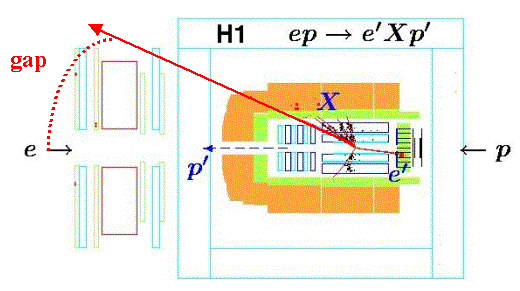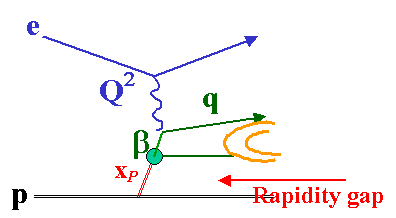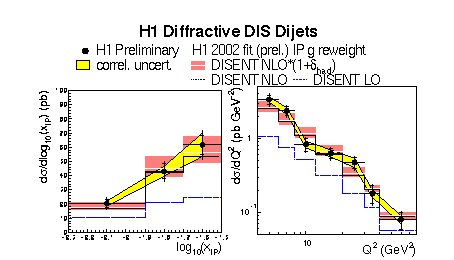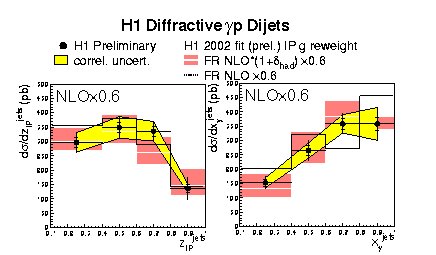 Fig.1
Fig.1
The study
of
high energy hadron-hadron scattering which is dominated by 'Pomeron'
exchange
has become a new testing ground of QCD. The
interest has been
revived by the HERA e-p experiments. In deep inelastic
scatteringa
virtual photon with four momentum transfer Q is scattered
from partons in
the proton. Since W2 = (1-x)Q2 /x ,
where
W is the center of mass energy of teh gamma*-p system,
high energy
gamma*-p
scattering is equivalent to the measurement of the inclusive structure
function F2 (W2, Q2 )
at low x. The
observed
rise of F2 towards low x is therefore equivalent to the rise
of the gaamp*-p cross section for high center of mass energies W2.
The gamma-p
scattering
process can of course also be described in the proton rest system. Then
we have the following situation (see fig.1):
 Fig.1
Fig.1
The photon
fluctuates
into a q-qbar pair far outside of the proton. The q-qbar
pair
travels an average distance d~ 1/x of about 50 fm before it
hits
the proton and
the transverse size of the pair is r = .2 GeVfm /Q
[GeV]
.
Gamma-p
scattering is therefore equivalent to the scattering of a
color
dipole (the q-qbar pair) of variable size with the proton. Its size can
be adjusted by choosing Q2 .
At
high Q2 this pair has a size much smaller
than 1 fm which
can be treated perturbatively and which has a small cross section
because
the color charge is well shielded. For photoproduction
(Q2 =
0) the dipole size has the size of a typical hadron, the total cross
section
for photoproduction rises therefore with the same slope as p-p at high
energy.
HERA physics
offers
hence the chance to study the high energy cross sections of color
dipoles
of adjustable size with the proton.
Hard diffractive scattering processes, where the proton is left intact
offer a second chance to study Pomeron structure in more detail. They
are
identified in the
detector by either observing an elastically scattered proton or by
requiring
a 'rapidity gap' between the scattered proton and the
observed hadronic
system. A typical event is shown in figure 2.


Event with a rapidity gap in the H1
detector
Diagram for diffractive scattering in the 'resolved pomeron" model
These
processes
are described by the exchange of the colorless 'Pomeron' and the
subsequent
scattering of the photon on a parton with momentum
fraction beta
inside the pomeron.
Studies of inclusive deep inelastic diffractive processes at HERA have
shown, that the pomeron structure is dominated by gluons . Our group
has therefore
launched
a program to measure diffractive dijet production in DIS and
photoproduction
because these processes give a direct handle
on the gluon
content
of the Pomeron. They are dominated by photon-gluon processes e.g. the
gluon
in the pomeron enters the scattering process directly.
Diffractive dijet cross -sections in the variable zp, the momentum
fraction
of gluons in the pomeron, are shown below for DIS and
phtoproduction.

a) cross
sections of diffractive dijet production compared tp NLO QCD
predictions
based on QCD factorisation and diffractive parton densities derived
from QCD fits
to the diffractive structure function F2D

b) same
as a) but now for photoproduction. The NLO prodiction has to be
scaled
down by a factor S=0.6 +- 0.1 to describe the memasurements.
Fig.a) shows the dijet cross section for DIS
compared
to predicitons based on the NLO diffractive gluon distribution*
pomeron flux which are compatible
with the observed
scaling violations of F2D. The NLO QCD prediction is
in good agereement with the measurements.
This underlines that the diffractive
cross sections factorise for DIS. Diffractive
dijet cross sections in photoproduction are also well described in
shape
by the same parton distributions (b)
they are however suppressed by a factor S=0.6+-
0.1 . This supression is the same for both resolved and
direct contibutions.
This shows that factorisation does not hold for all
diffractive processes in line with earlier measurements at the Tevatron.
New results are published as conference contributions: dijets in diffractive photoproduction and DIS